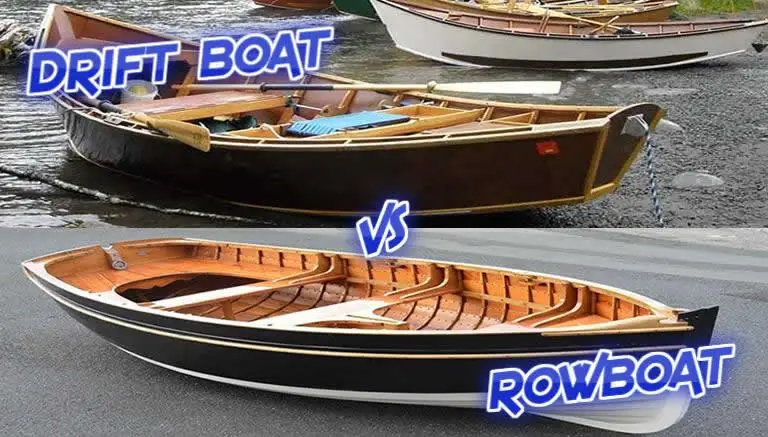Contents
Drift Boat vs Rowboat
Drift boats are better for shallow and moving water, while rowboats are better for deep and still water.
Rowboats are v-hull fishing vessels that perform well in deep water.
They are unsuitable for shallow water use.
Drift boats are flat bottomed vessels that are excellent river runners.
They perform well in turbulent rivers with whitewater and rapids up to class IV. They are not the best choice for deep still water.
Although both the drift boat and the traditional rowboat are powered by oars they are very different vessels, with very different purposes.
Let’s take a look at the similarities and differences between these two iconic fishing vessels so you can see which one is a better fit for your individual needs.
Drift boat basic characteristics
A drift is an inland waterway vessel that is designed to be used in rivers.
Its flat bottom hull, with its distinctively curved shape, makes it perfect for river running in turbulent rivers.
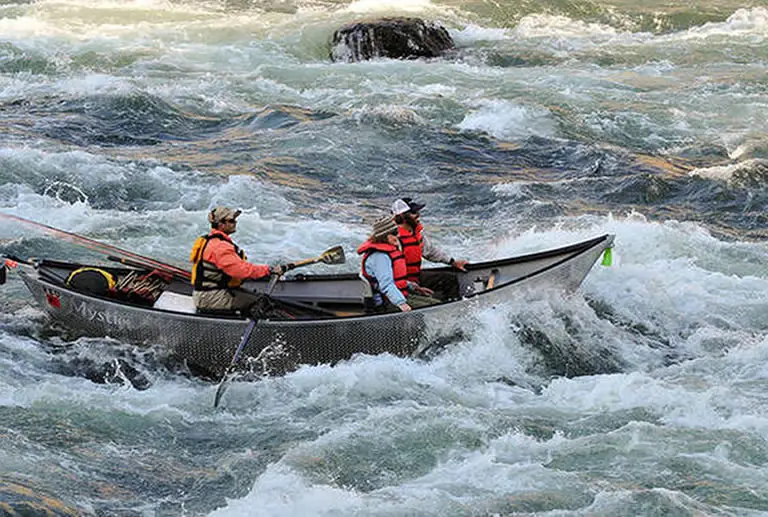
The drift boat evolved from the dory boat which was used in ocean bays for fishing, so it is a natural-born fishing vessel.
However, as the boat needed to be used in the turbulent rivers of Oregon, namely the Rogue River and McKenzie River, certain changes needed to be made to the basic hull design of the dory so the boat could handle whitewater and rapids.
Thus, the drift boat was born.
To learn more about the history and evolution of the drift boat read this article.
Although both a rowboat and a drift boat can be fitted with a trolling motor, a drift boat has very strict restrictions on how this can be done.
The size of motor and also the way the motor is mounted on the boat is of major concern.
It is essential you get the size and mounting correct when putting a motor on a drift boat as these flat bottomed inland vessels were never meant to be motorized. Adding mechanical propulsion to one must be done with care!
Rowboat basic characteristics
A rowboat is more of an open water vessel than a drift boat.
It is not designed for use on rivers.
The v-hull design of a rowboat makes it much more efficient for deep water use.
For the same reasons that this boat is more than capable of being used ocean water use, it is also capable of being used in deep lakes and ponds.
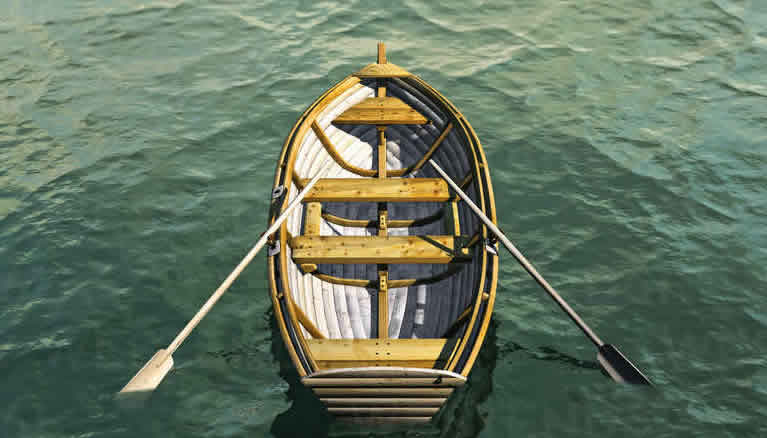
It is much easier to mount a motor on a rowboat as there are a lot less restrictions on its motorized use.
A rowboat handles well with a trolling motor mounted on it.
Similarities of a drift boat and rowboat
Both the drift boat and the rowboat are powered by manual propulsion.
Both are row boats that rely on oar power to get them moving.
Although the traditional rowboat has been used for various water-based activities, including as a lifeboat on larger vessels, it has always been a very successful fishing vessel.
Likewise, the drift boat is also a very popular fishing vessel but is used in a very different way from a rowboat and in very different environments, as I will explore in this article.
Although a rowboat and s drift boat look somewhat similar on first glance, they are very different boats with very different hull designs.
Differences between a drift boat and rowboat
The main difference between a rowboat and a drift boat lies in the hull design.
This difference in hull shape makes these boats almost complete opposites.
To see how these boats differ I will cover each separately below before giving the advantages and disadvantages of each.
Advantages And Disadvantages Of Each Boat
Below are the advantages and disadvantages of each of these boat types.
As you will soon see, each boat performs better in specific marine environments while it remains totally unsuitable for other marine environments.
Drift boat pros & cons
The flat bottom, and shallow draft, hull of a drift boat makes it excellent for rivers where there are large areas of very shallow water.
Additionally, the boat is also capable of being used in some very turbulent river waters as its high sides and curved hull means it can deflect spray easily.
However, the boat’s shallow draft, flat bottom and high sides become a very distinct disadvantage in deep, open water.
A drift boat is not suitable for ocean use because it experiences stability issues in turbulent ocean waves.
Although it can easily handle up to class IV rapids it struggles in deep turbulent open waters.
It’s lack of secondary stability and flat bottom makes it difficult for the boat to remain stable in ocean waters.
Although a drift can be used on a lake, the same problems that make it unsuitable for ocean use make it uncomfortable to use in the deep open waters of a lake.
The high sides tend to catch the wind and it can be difficult to control the boat on still water, making fishing problematic.
This is not to say that a drift cannot be used for fishing.
A drift boat is a truly excellent fishing vessel but only when it is used in the correct way.
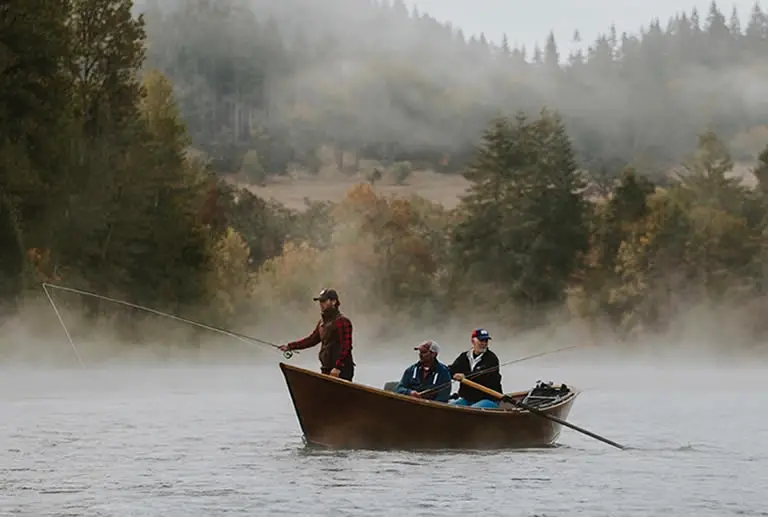
A drift boat is a “drifter” and performs at its best “on the move” even when fishing.
This is a very effective fishing method that nets a lot of catch and is known as drift boat fishing.
Drift boat fishing involves the boat moving continually upstream while the angler fishes downstream from a standing position at the bow of the boat.
Most drift boat fishing is done with a guide on a rental boat. This is because the activity requires an oarsman to control the boat while the angler casts off. Though almost all drift boat owners will also fish in this manner at some time.
Although you can fish off a stationary drift boat this will need a strong anchor hold and may even require double anchoring the boat. This is because the wind can catch the sides of a drift boat and jostle it around on the water making it unstable to stand on.
Although a great fishing vessel where a drift boat really excels is in turbulent rivers.
A drift boat was made to be a river runner and is one of the only traditional style boats that can keep up with a modern river running raft or kayak!
The drift boat has the ability to navigate class IV rapids and turbulent whitewater, and turn on a dime.
So it is not unusual to see drift boats, even wooden ones, being used to navigate rivers with canyon boulders and rapids that only rafts and whitewater kayaks are usually seen on.
However, it’s not all sunshine and roses.
Drift boats are difficult to row in still water and require physical effort to move upstream.
The flat bottom hull design does not lend itself well to moving through still water or moving against the current.
For this reason many people consider drift boats to be downstream vessels only.
Though this is not, strictly speaking, entirely true, rowing a drift in still water or upstream can be very tiring.
Drift boat fishing and river running (video)
Rowboat pros and cons
Although powered by oars a rowboat is a very different vessel from a drift boat.
A rowboat has a v-hull that allows it to perform better in deep water.
It also gives the boat the capability of being used safely in ocean waters.
In deep waters a rowboat works excellently well for anglers who can cast off while remaining seated.
The v-hull design of a rowboat means it can handle choppy water very well but it is also a better choice for stationary fishing when compared to a drift boat.
Though most flat bottom boats offer better stability on still water, like a Jon boat for example, a drift boat differs.
Where wind will catch the sides of a drift boat and push the boat about on the water it will have little affect on the lower freeboard and v-hull of a rowboat.
Although the rowboat will rock more on still water than other types flat bottom vessels it is still a better choice than a drift boat.
A rowboat is much easier to row on still water than a drift boat.
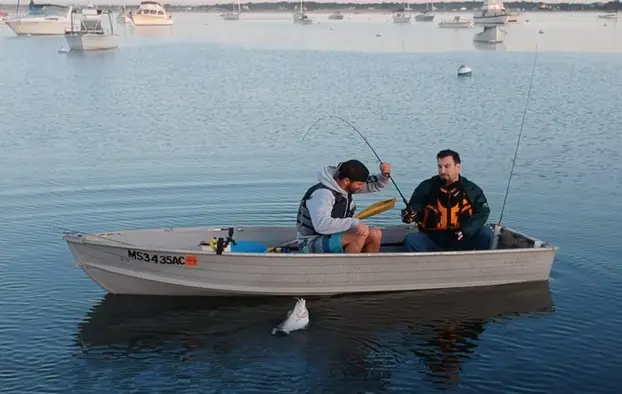
It is also easier to row upstream as the v-hull design of the boat means it cuts through the water better than the flat hull of a drift boat.
Of course there are disadvantages to using a rowboat as well.
A rowboat excels in deep water but it cannot be used in the type of shallow water a drift boat can be used in.
Hence, a rowboat is better for deep waters like ocean bays and lakes but is unsuitable for most rivers because its draft is too deep.
A drift boat’s flat bottom gives it the shallow draft that allows it access to very shallow water, even letting it slide over obstacles on the bottom.
The v-hull shape of a rowboat means it would run aground in the same water.
So when using a rowboat you must stick to fairly deep waters or at least avoid the shallows.
Rowboat easily handling deep rough water (video)
Cost Comparison Between Drift Boats And Rowboats
Both drift boats and rowboats can be very expensive, though drift boats costs considerably more.
Drift boats are very expensive costing from $8,000 up to about $24,000 for standard boats. When you start adding extras the cost goes up fast.
One way to reduce costs is to simply build the boat yourself. To see the cost of average cost of building a drift boat read this article.
If you want to know why you should build or buy a drift boat read this.
Traditional wooden rowboats are seriously pricey and can cost $20,000 or more, though you can get 12 – 14 foot aluminum rowboats for a few thousand dollars.
Aluminum drift boats are also popular.
Just be aware that of you purchase an aluminum rowboat you need to treat it with special chemicals if you intend to use it in saltwater.
Read our article about doing that on an aluminum Jon boat here.
Both boat types are considerably cheap to build.
With improvements in marine plywood and boat building supplies you can build either a drift boat or a rowboat for a fraction of the cost of a store-bought new one.
Just make sure you use the appropriate boat plans.
Summary: Rowboat vs Drift Boat
Rowboats are better for deep water and stationary fishing.
If you plan to use your boat in ocean bays and lakes then a rowboat is by far the best choice.
Just be sure to protect an aluminum rowboat from galvanic corrosion in saltwater.
The v-hull of the boat offers more stability in deeper waters while it, and the lower freeboard, gives the boater an easier time while stationary fishing.
A rowboat is also a lot easier to row in still water and upstream than a drift boat.
A drift boat requires real physical effort to row in still water and against the current.
If you plan to boat in rivers then the flat bottom, and shallow draft, hull of a drift boat is what you need.
A drift boat can handle almost any type of river water, even rivers with turbulent whitewater and class IV rapids.
Both boats work well for fishing, though in different marine environments and for different fishing styles.
Both boats can be used for recreational use, such as boat camping, although a drift boat usually wins out as a rowboat cannot be taken onto most rivers.
A rowboat is usually restricted to deep lakes and the ocean.
Both boats are expensive though you can build your own for a fraction of the cost with the correct boat building plans.

